A Low-Cost, Energy-Aware Exploration Framework for Autonomous Ground Vehicles in Hazardous Environments
Abstract
1. Introduction
1.1. Related Work
1.2. Motivation and Contribution
- Low-cost autonomous exploration platform: A co-designed hardware–software AGV is used with components optimally selected in terms of price, modularity, and flexibility of deployment into constrained spaces.
- Energy-aware navigation: A battery management subsystem is included that actively manages behavior in response to the available energy, causing safe backtracking (i.e., return to starting point) before loss of energy.
- State logging: In addition, SD card-based persistent state logging allows the whole range of traversal decisions, energy states, and image triads to be stored on an SD card, which makes the implementation attractive for resource-constrained platforms by allowing robust and memory-efficient exploration.
- Off-line video reconstruction: A wide-angle camera placed on a servo mount captures ordered images (sets of three images per capturing) and the off-line video reconstruction utilizes these triads of sequential images at each decision point to later form a panoramic image. The captured triads of images are merged into single frames that are later ordered to form a video.
2. Materials and Methods
2.1. Investigation Algorithm
- Search Initialization. Data structures are established just before exploration begins, with such items as the visited set, movement logs and path logs, and the frontier (a queue or stack with BFS or DFS, respectively). Such operations require constant time, and they require a complexity of .
- Exploration Loop. The main exploration routine involves repeatedly consuming battery, taking one node on the frontier, examining its neighbors, and updating logs, while the procedure continues until the battery runs low/empty. As every single node is explored just once and moves are limited by k, a step will take place within time where .
- Backtracking on Low Battery. As soon as the battery level of the AGV falls below , it reverses its way back by recording every move and loses more battery with every step. This phase is also , because as the path has already been stored, the backtracking on it will occupy not more than k steps. On this point we should note that since the path so far is recorded alongside the decision point, through the backtracking procedure the reversed path is followed without requiring the peripherals to be utilized, thus saving battery level as it consumes less energy.
- Total Time and Space Complexity. As exploration and backtracking have time complexity up to each and , the total time complexity is . The level of space complexity is also as a result of storing of the visited set, movement records, and the path history.
| Algorithm 1: Explore procedure (AGV map search with backtracking). |
| Input: Graph G, Start node , Algorithm type , Battery B, Drain per step d Output: MovementLog, PathLog  |
| Algorithm 2: GetNeighbors. |
| Input: NodeData: map of directions to nodes Output: List of  |
| Algorithm 3: ReverseDirection. |
| Input: Direction d Output: Opposite Direction 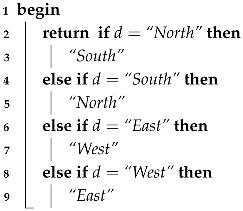 |
2.2. Energy Management
- All navigable points have been visited (full exploration).
- The remaining battery energy is below the critical threshold of , initiating an emergency return to start (i.e., backtracking procedure).
- Base Movement Cost: Each step forward, regardless of direction, costs 1 unit of energy.
- Camera Operation Cost: The AGV captures 3 images per step for visual inspection and mapping, resulting in a fixed additional cost of 3 units per step.
- Sonar Directional Cost: A sideways sonar scan is triggered when the AGV changes movement direction (e.g., from north to east). Each directional change incurs an extra cost of 2 units.
2.3. Traversal Constraints in Unknown Maze Exploration
3. System Architecture
3.1. System Components
- Microcomputer Board: The microcomputer board is composed of the Raspberry Pi Zero board, which coordinates the whole system, aligning the operation of the sensors with the navigation functionalities and logging. This component acts as the central controller coordinating navigation, perception, and decision-making under limited memory and processing resources; it stores decisions and traversal data on an SD card for energy-efficient, long-term operation and reliable backtracking.
- Navigation Sensors: These consist primarily of ultrasonic sensors that guide the AGV through obstacle detection and simple environmental perception, ensuring low-cost yet effective autonomous navigation in resource-constrained settings.
- Visual Mapping: This employs a fish-eye camera mounted on a servo motor to capture sequential images (left, center, and right), stored for off-line integration into a low-frame-rate video, enhancing environmental awareness without requiring heavy on-board processing.
- DC Motor System: This provides mobility for the AGV in hazardous or inaccessible environments, executing control signals from the microcomputer to perform exploration and secure return-to-base operations when energy thresholds are reached.
- Path Planning: This implements traversal algorithms (BFS, DFS, and ) to guide exploration, balance efficiency and energy use, and ensure robust backtracking when retreat is required due to environmental hazards or energy constraints.
- Energy Monitoring: This tracks power consumption to enforce energy-aware decisions, halting exploration and initiating safe return when the battery level falls below 50%, ensuring mission continuity while protecting system integrity.
- Logging Module: This records traversal paths, sensor data, and decision history on the SD card, enabling reproducibility, secure backtracking, and post-mission analysis to validate performance and improve robustness.
3.2. Navigation Subsystem
Heading Error Compensation
- H1 (Gyro Bias Leak): This mechanism continuously estimates and compensates for gyroscope bias during straight-line motion, when the commanded angular velocity is near zero. By comparing measured and commanded yaw rates, the bias estimate is updated incrementally, limiting long-term drift accumulation.
- H2 (Snap-to-Turn Correction): When discrete turns (e.g., at corridor junctions) are completed, the heading estimate is “snapped” to the nearest canonical orientation (such as multiples of ). This heuristic reduces residual angular error after large maneuvers and exploits the structural regularity of indoor environments.
- H3 (Magnetometer Complementary Correction): If a magnetometer is available, its absolute heading estimate is blended into the gyroscope-based estimate using a complementary filter. This provides coarse global orientation anchoring, mitigating long-term drift at the cost of potential sensitivity to local magnetic disturbances.
- H4 (Wall-Normal Alignment): When front-facing ultrasonic pairs detect a wall, the angular offset relative to the wall normal is estimated geometrically. Small corrections are applied to realign the robot, improving navigation accuracy in bounded spaces such as hallways.
- H5 (Corridor Alignment): Similarly, side-facing ultrasonic pairs allow estimation of lateral symmetry within corridors. By correcting deviations when left and right ranges are imbalanced, the robot maintains central alignment, which reduces systematic angular drift during straight-line exploration.
- H6 (Motion Consistency Check): The predicted change in front range, given the forward velocity and prior distance, is compared against measured ultrasonic readings. Consistent discrepancies are attributed to angular drift and used for correction. This opportunistically leverages redundancy between odometry and range sensing for self-calibration.
- H7 (Zero-Rate Window Calibration): When the robot is stationary, both commanded and measured angular velocities should ideally be zero. By averaging residual gyro outputs during such intervals, bias estimates are updated with high confidence, reducing long-term systematic error.
- H8 (Deadband and Hysteresis): To avoid excessive corrections from sensor noise, heading updates are applied only when deviations exceed a small threshold. Within this deadband, heading is smoothed using a hysteresis factor, preventing oscillations and overcompensation.
3.3. Logging Subsystem
| Algorithm 4: Angular correction. |
| Input: (gyro yaw rate), (commanded yaw rate), v (forward speed), (front-left/right sonar), (side sonar), (front sonar), L (sensor baseline) Input: Parameters: Output: Corrected heading , updated bias 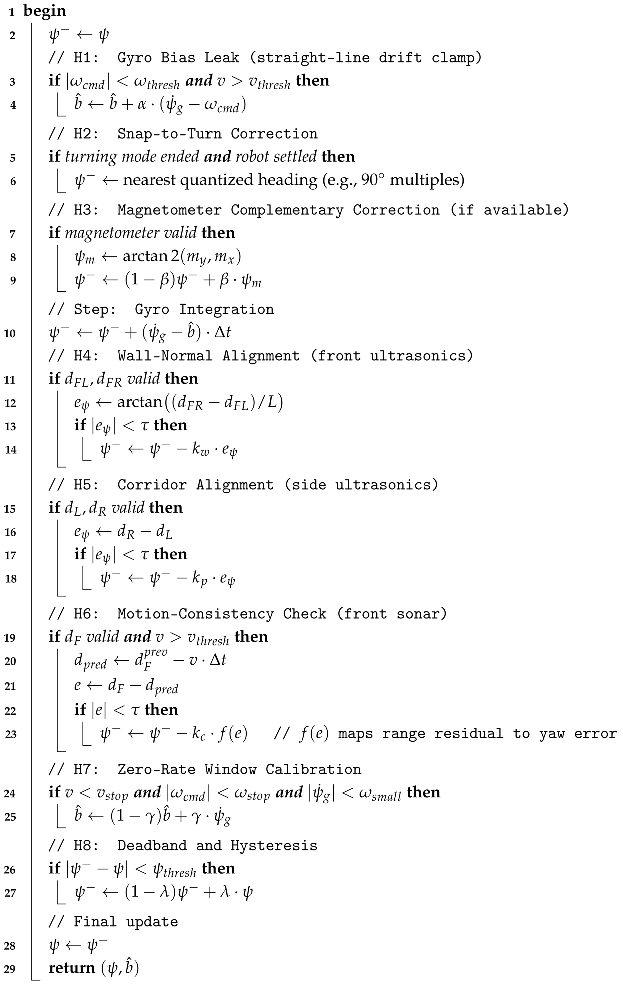 |
3.4. Energy Awareness Subsystem
4. Experimental Evaluation
4.1. Experimental Design
- In the experimental set-up, three major factors are distinguished:
- Maze Configuration and Variability: There were ten different maze configurations developed, which resulted in variability in layout and structural complexity. The mazes proposed were realistic in terms of creating an environment in which an automated guided vehicle (AGV) would find itself in a real-life situation, i.e., warehouses or structured indoor areas.
- Starting Point Randomization: Different starting points: Ten start points were chosen randomly for each maze so that there was a wide variety of initial conditions and no bias was caused by the particular position of entering the maze. This randomization was used to record an entire picture of the irregular algorithmic behavior in spatial variability.
- Algorithm Deployment: Using each of the ten starting positions in each of the mazes (that is, 100 total scenarios), the three algorithms, BFS, DFS, and A, were run separately. All the algorithms undertook a complete exploration phase beginning at the starting point, exploring the maze on the basis of their own logic and strategy.
- 1.
- Percentage of visited cells, denoted as , describes the degree of exploration.
- 2.
- Energy consumption, denoted as E, is an estimate of the costs or resources that are consumed in the process of exploration.
- 3.
- Efficiency rate, denoted as , depicts the ratio of the number of visited cells to the total energy consumed () and is taken as the rate at which the algorithms change energy into coverage of the area.
4.2. Software Implementation and Simulation Experiments
- Simulated hardware interfaces for motors, sensors, the camera, and storage.
- Modular code organization to separate control logic, hardware abstraction, and utility functions.
- A realistic approximation of sensor readings and battery behavior to validate the navigation algorithm.
- Logging features to trace decision-making and movement sequences.
- 1.
- Maze Initialization: The Maze Manager loads or generates 10 distinct maze configurations. Each maze is represented as a 2D grid or graph structure, where nodes represent cells and edges denote valid movements.
- 2.
- Starting Point Selection: For each maze, the Start Point Generator randomly selects 10 valid starting positions (i.e., non-wall cells). These starting positions are stored to ensure consistency across algorithm evaluations.
- 3.
- Algorithm Deployment Loop: The simulation software generates 10 random mazes and randomly selects 10 valid starting positions within the maze. For every starting point, each of the three exploration algorithms (BFS, DFS, and ) is executed independently. During the exploration, the system tracks the number of visited cells, estimates energy consumption based on movement or action steps, and computes the efficiency as the ratio of visited cells to energy used.
- 4.
- Results Aggregation: After completing all 300 simulations (10 mazes × 10 points × 3 algorithms), the Results Aggregator computes the values of , E, and .
4.3. Discussion of the Exhibited Results
5. Conclusions
5.1. Potential and Limitations
5.2. Future Research
Author Contributions
Funding
Acknowledgments
Conflicts of Interest
References
- Maidana, R.; Granada, R.; Jurak, D.; Magnaguagno, M.C.; Meneguzzi, F.R.; de Morais, A.A. Energy-aware path planning for autonomous mobile robot navigation. In Proceedings of the 33rd International Florida Artificial Intelligence Conference, North Miami Beach, FL, USA, 17–20 May 2020. [Google Scholar]
- Rappaport, M. Energy-aware mobile robot exploration with adaptive decision thresholds. In Proceedings of the ISR 2016: 47st International Symposium on Robotics, Munich, Germany, 21–22 June 2016; VDE: Offenbach am Main, Germany, 2016; pp. 1–8. [Google Scholar]
- Mei, Y.; Lu, Y.H.; Lee, C.G.; Hu, Y.C. Energy-efficient mobile robot exploration. In Proceedings the 2006 IEEE International Conference on Robotics and Automation, 2006. ICRA 2006, Orlando, FL, USA, 15–19 May 2006; IEEE: Piscataway, NJ, USA, 2006; pp. 505–511. [Google Scholar]
- Teixeira, J.M.X.; Pimentel, N.; Barbier, E.; Bernard, E.; Teichrieb, V.; Chaves, G. Low-Cost 3D Reconstruction of Caves. In Proceedings of the 18th International Joint Conference on Computer Vision, Imaging and Computer Graphics Theory and Application VISIGRAPP (5: VISAPP), Lisbon, Portugal, 19–21 February 2023; pp. 1007–1014. [Google Scholar]
- Rejab, K.S.; Abd-Al Hussain, S.M.N. Design and implementation of intelligent mobile robot based on microcontroller by using three ultrasonic sensors. Int. J. Curr. Eng. Technol. 2017, 7, 2051–2056. [Google Scholar]
- Azeta, J.; Bolu, C.; Hinvi, D.; Abioye, A.A. Obstacle detection using ultrasonic sensor for a mobile robot. Iop Conf. Ser. Mater. Sci. Eng. 2019, 707, 012012. [Google Scholar] [CrossRef]
- Kerstens, R.; Laurijssen, D.; Steckel, J. ERTIS: A fully embedded real time 3d imaging sonar sensor for robotic applications. In Proceedings of the 2019 International Conference on Robotics and Automation (ICRA), Montreal, QC, Canada, 20–24 May 2019; IEEE: Piscataway, NJ, USA, 2019; pp. 1438–1443. [Google Scholar]
- Meneses, J.; Barrientos, A.; Gonzalez, J. Using Optical Flow for Robot Navigation in Low-Power Platforms. Sensors 2016, 16, 2122. [Google Scholar] [CrossRef]
- Khan, S.; Daudpoto, J. Development of Low-Cost Autonomous Robot. In Proceedings of the 2019 Innovations in Intelligent Systems and Applications Conference (ASYU), Izmir, Turkey, 31 October–2 November 2019; pp. 1–6. [Google Scholar] [CrossRef]
- Ziouzios, D.; Kontarinis, G. Raspberry Pi Based Obstacle Avoidance Robot Using Ultrasonic Sensors. J. Eng. Sci. Technol. Rev. 2019, 12, 145–150. [Google Scholar] [CrossRef]
- NTNU Open. Obstacle Avoidance Robot with Ultrasonic Sensors Using Raspberry Pi; NTNU Open: Trondheim, Norway, 2021; NTNU Project Archive. [Google Scholar]
- Seewald, A.; Lerch, C.J.; Chancán, M.; Dollar, A.M.; Abraham, I. Energy-Aware Ergodic Search: Continuous Exploration for Multi-Agent Systems with Battery Constraints. In Proceedings of the 2024 IEEE International Conference on Robotics and Automation (ICRA), Yokohama, Japan, 13–17 May 2024; pp. 7048–7054. [Google Scholar] [CrossRef]
- Ben Naveed, A.; Jain, A.; Lavelle, M. ECLARES: Energy-Constrained Ergodic Control for Exploration and Environmental Sensing. Robotics 2021, 10, 115. [Google Scholar] [CrossRef]
- Zhang, Y.; Ai, Z.; Chen, J.; You, T.; Du, C.; Deng, L. Energy-Saving Optimization and Control of Autonomous Electric Vehicles With Considering Multiconstraints. IEEE Trans. Cybern. 2022, 52, 10869–10881. [Google Scholar] [CrossRef] [PubMed]
- Dovgan, E.; Jogan, M. Energy-Aware Navigation with Dynamic Weighting for AGVs. IFAC-PapersOnLine 2020, 53, 8124–8129. [Google Scholar] [CrossRef]
- El-Hussieny, H.; El-Sayed, A. Modified DFS Algorithm for Robotic Path Planning in Unknown Terrains. Int. J. Comput. Appl. 2018, 179, 1–6. [Google Scholar] [CrossRef]
- Parasuraman, S. Sensor Fusion for Mobile Robot Navigation: Fuzzy Associative Memory. Procedia Eng. 2012, 41, 251–256. [Google Scholar] [CrossRef]
- Russell, S.; Norvig, P. Artificial Intelligence: A Modern Approach, 2nd ed.; Pearson Education: London, UK, 2003. [Google Scholar]
- Lambers, M.; Schindler, S. Visual Odometry Using Offline Image Logs in UAV Systems. Sensors 2019, 19, 910. [Google Scholar] [CrossRef]
- Rodríguez-Martínez, E.A.; Flores-Fuentes, W.; Achakir, F.; Sergiyenko, O.; Murrieta-Rico, F.N. Vision-Based Navigation and Perception for Autonomous Robots: Sensors, SLAM, Control Strategies, and Cross-Domain Applications—A Review. Eng 2025, 6, 153. [Google Scholar] [CrossRef]
- Zhou, T.; Wang, Y. Reconstructing Visual Environments from Sparse Image Logs. In Proceedings of the International Joint Conference on Computer Vision, Imaging and Computer Graphics Theory and Applications (VISAPP), Madeira, Portugal, 27–29 January 2018; pp. 623–630. [Google Scholar]
- Reyes, R.; Tovar, B. Energy Prediction in Mobile Robots Using Artificial Neural Networks. Sensors 2020, 20, 762. [Google Scholar] [CrossRef]
- Byun, H.; Yang, S. An energy-efficient and self-triggered control method for robot swarm networking systems. Meas. Control 2022, 55, 898–907. [Google Scholar] [CrossRef]
- Lai, J.; Wu, Z.; Ren, Z.; Tan, Q.; Xiao, H. Optimal navigation of an automatic guided vehicle with obstacle constraints: A broad learning-based approach. IEEE Trans. Emerg. Top. Comput. Intell. 2025, 9, 3010–3024. [Google Scholar] [CrossRef]
- Nowakowski, M.; Kurylo, J.; Braun, J.; Berger, G.S.; Mendes, J.; Lima, J. Using LiDAR data as image for AI to recognize objects in the mobile robot operational environment. In Proceedings of the International Conference on Optimization, Learning Algorithms and Applications, Ponta Delgada, Portugal, 27–29 September 2023; Springer Nature: Cham, Switzerland, 2023; pp. 118–131. [Google Scholar]
- Project on GitHub. Available online: https://github.com/IosifPolenakis/EA-AGV/blob/main/maze.zip (accessed on 11 September 2025).
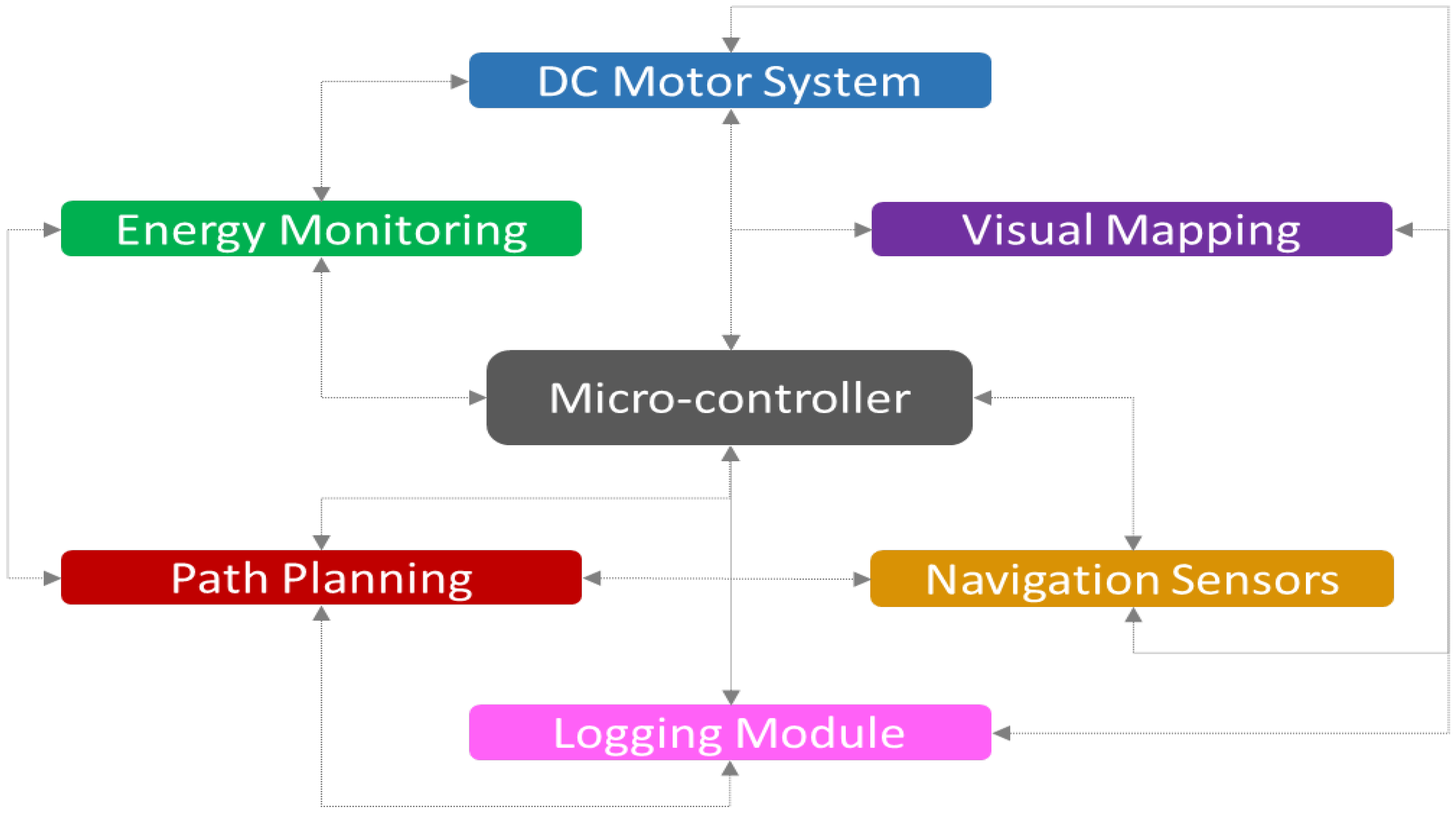
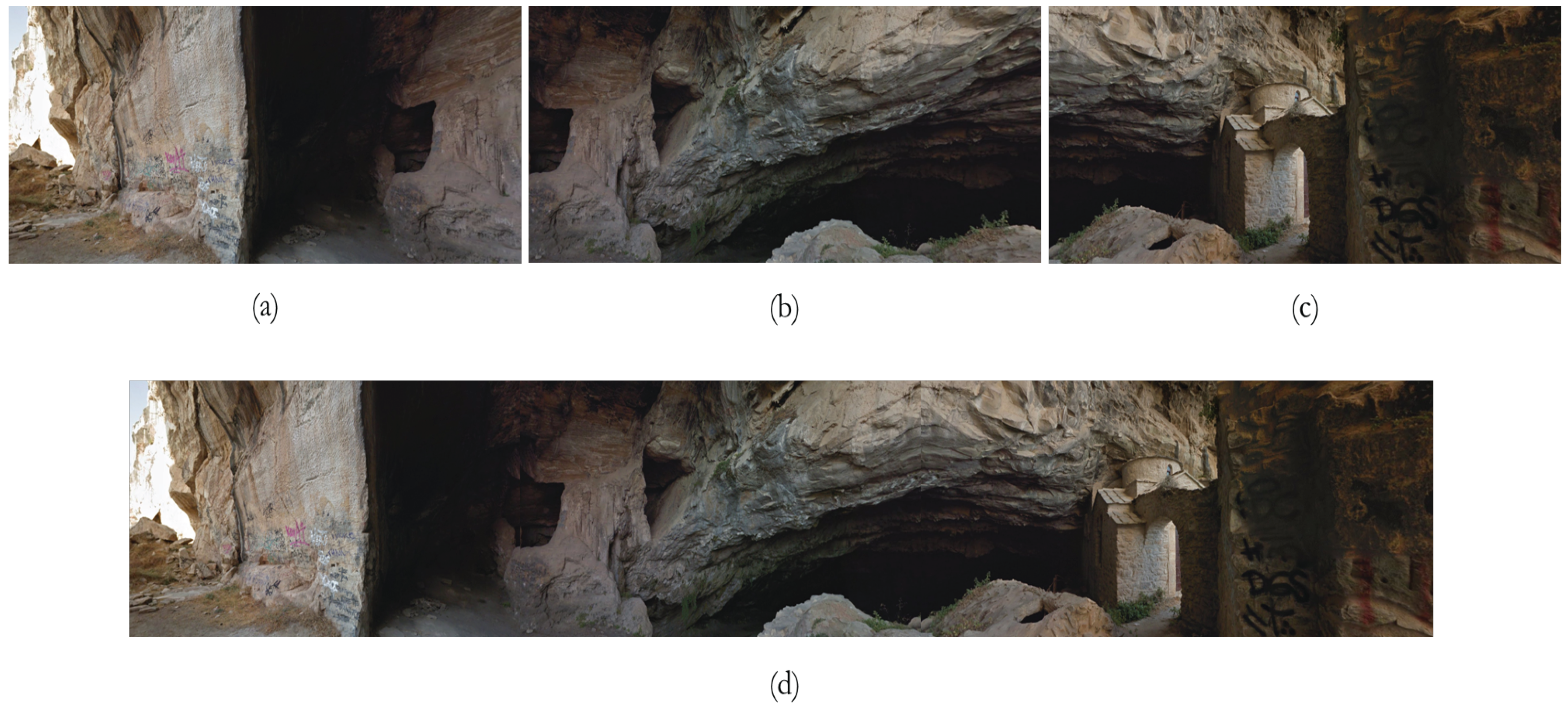
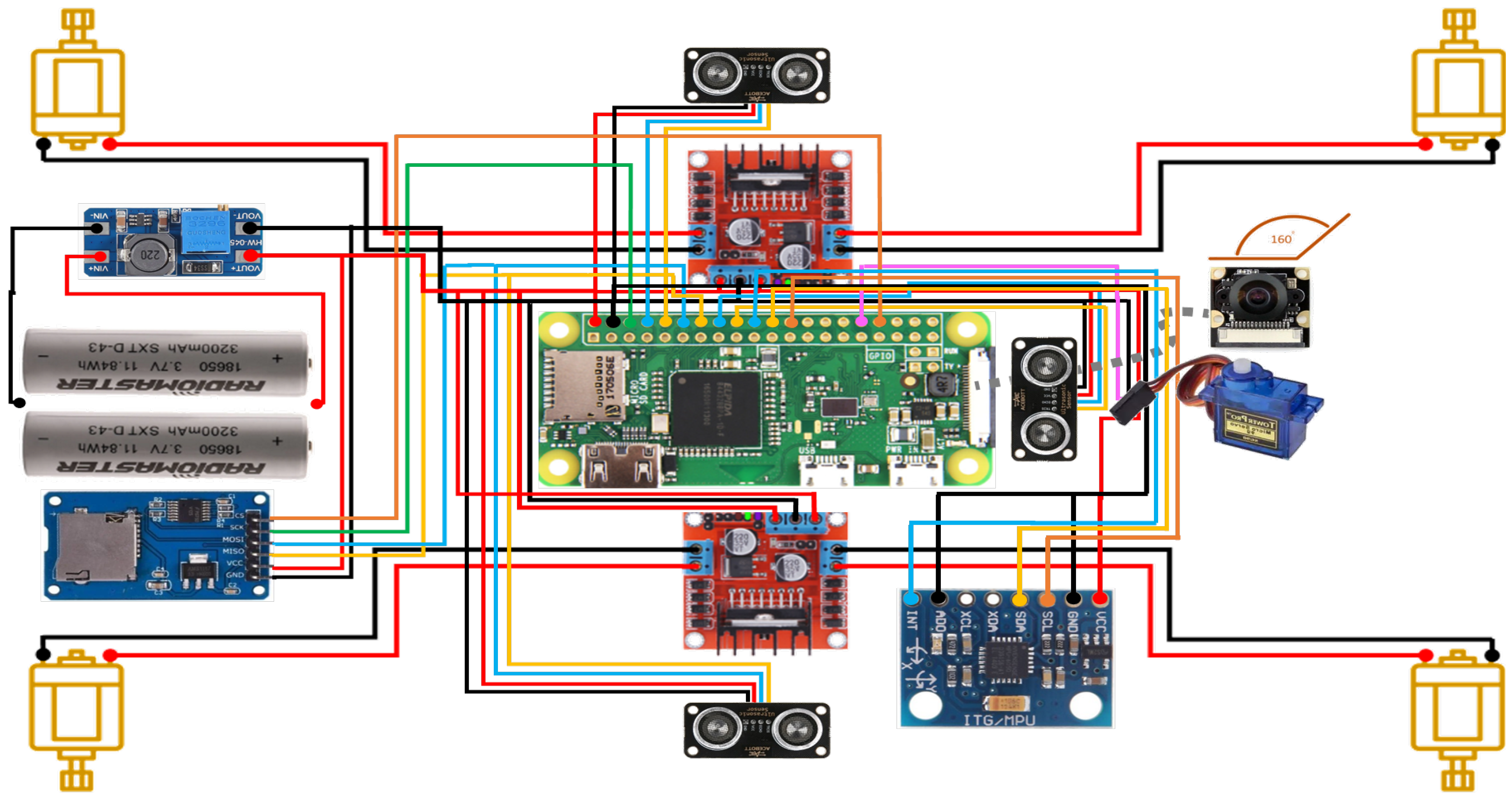
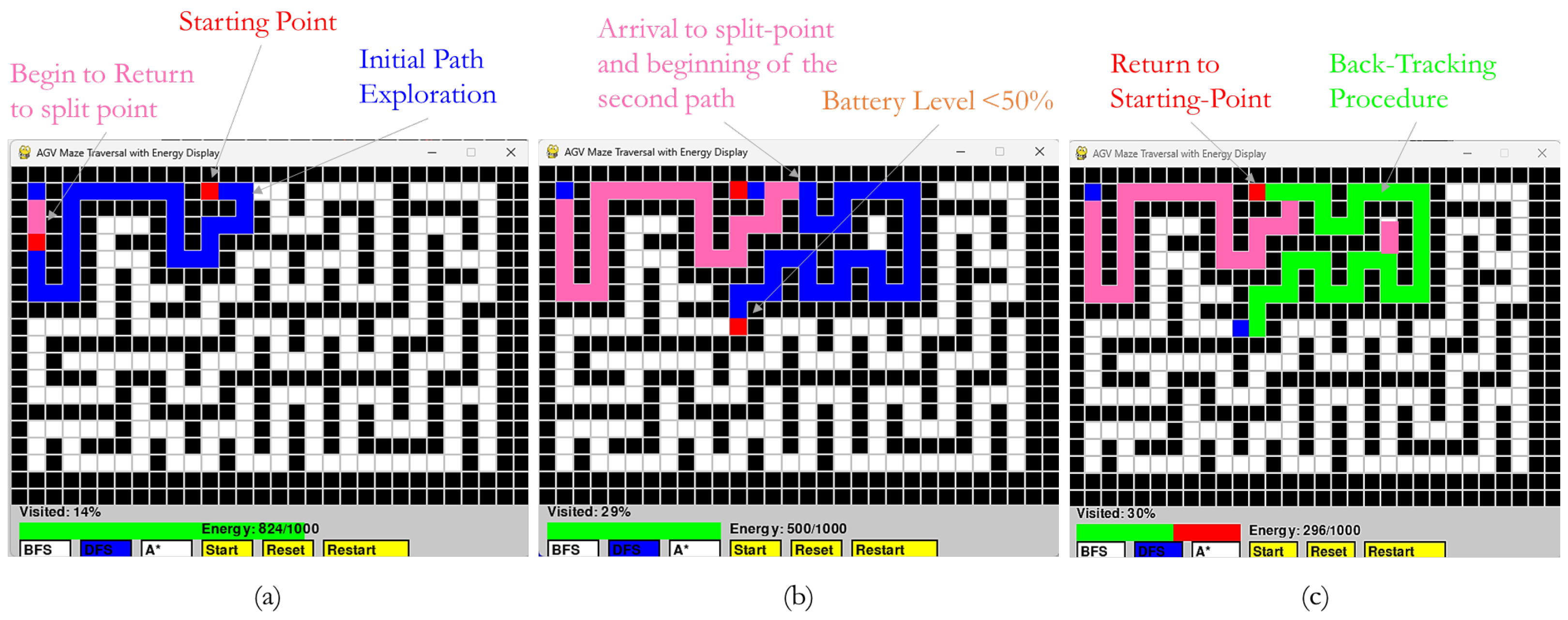
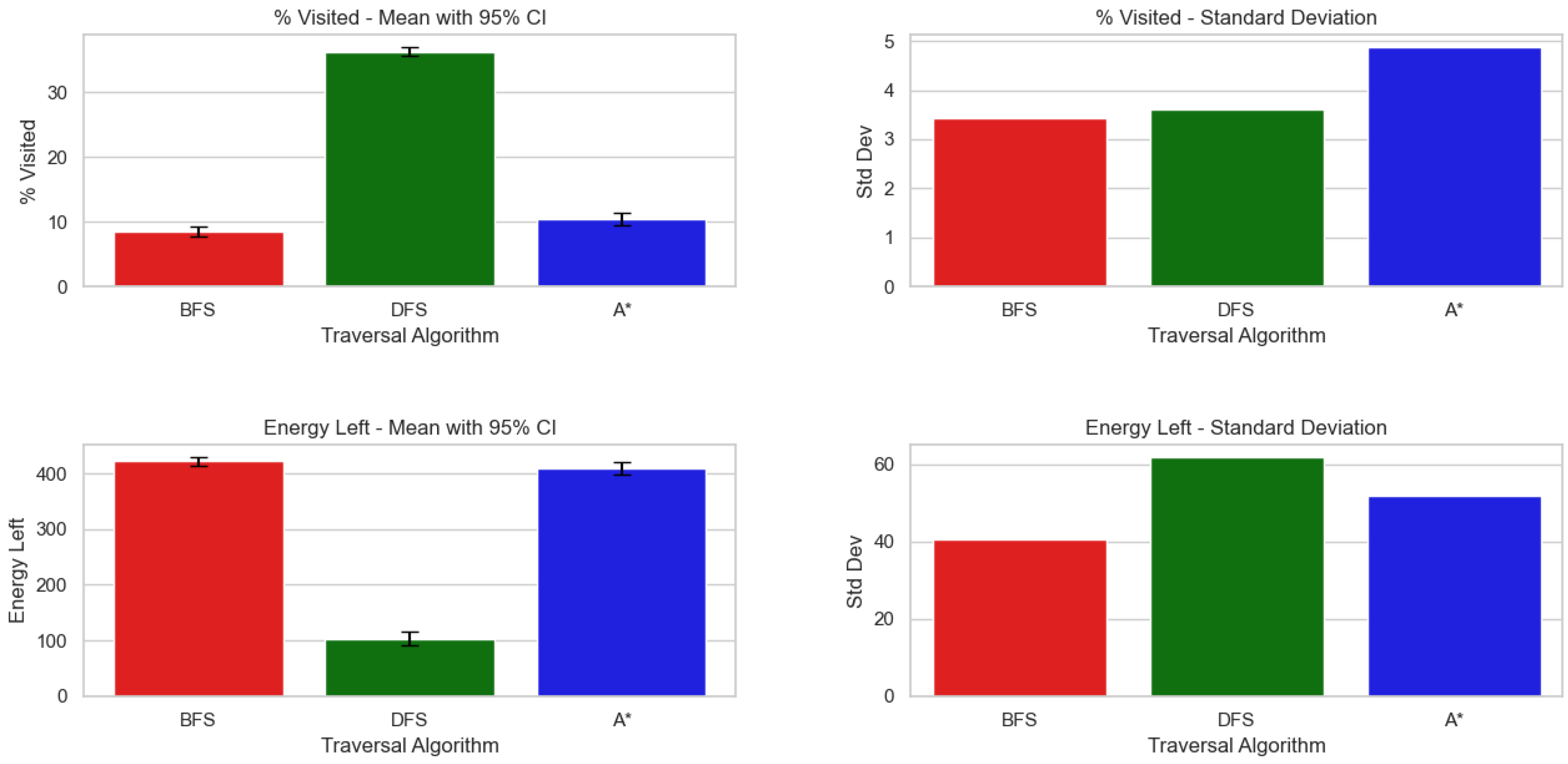
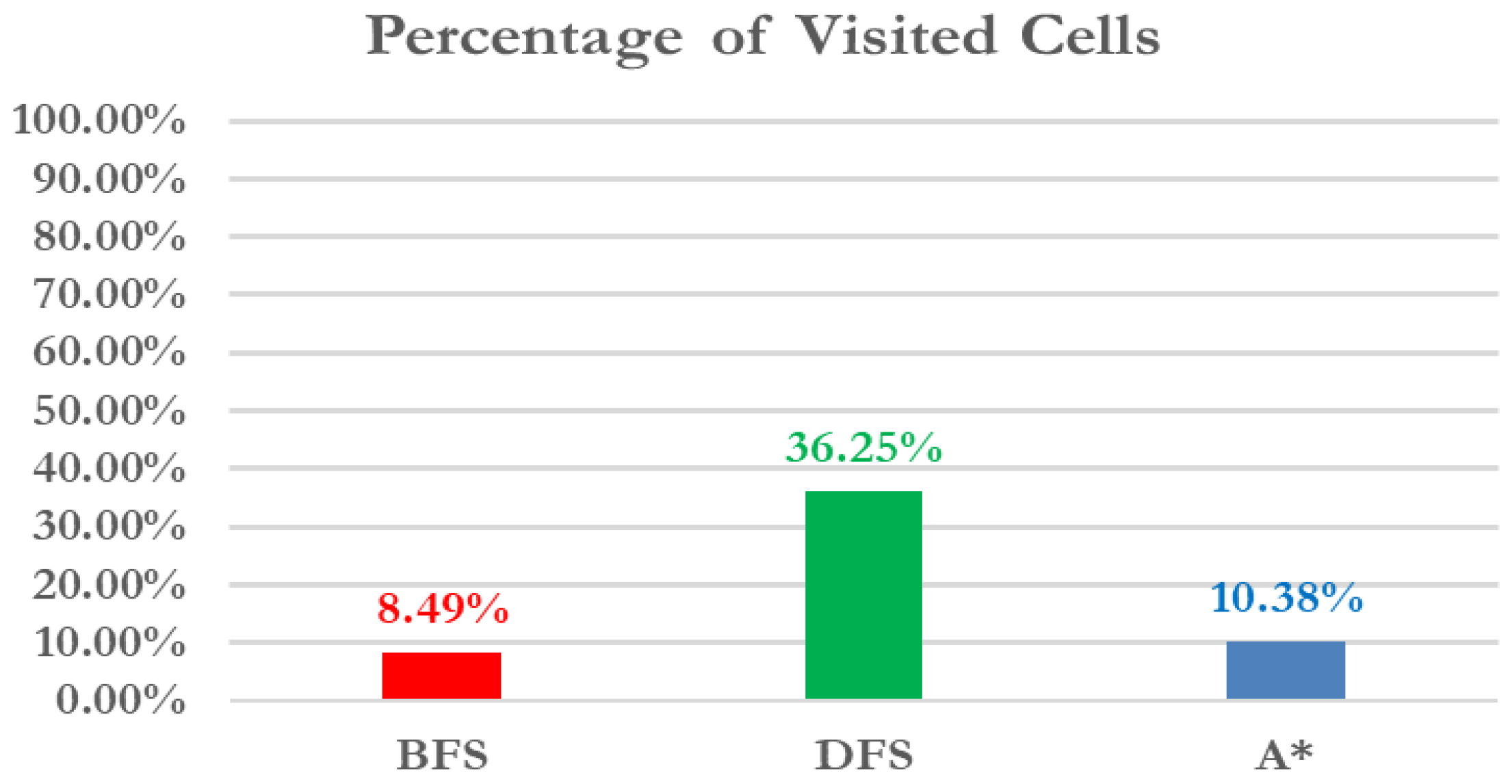
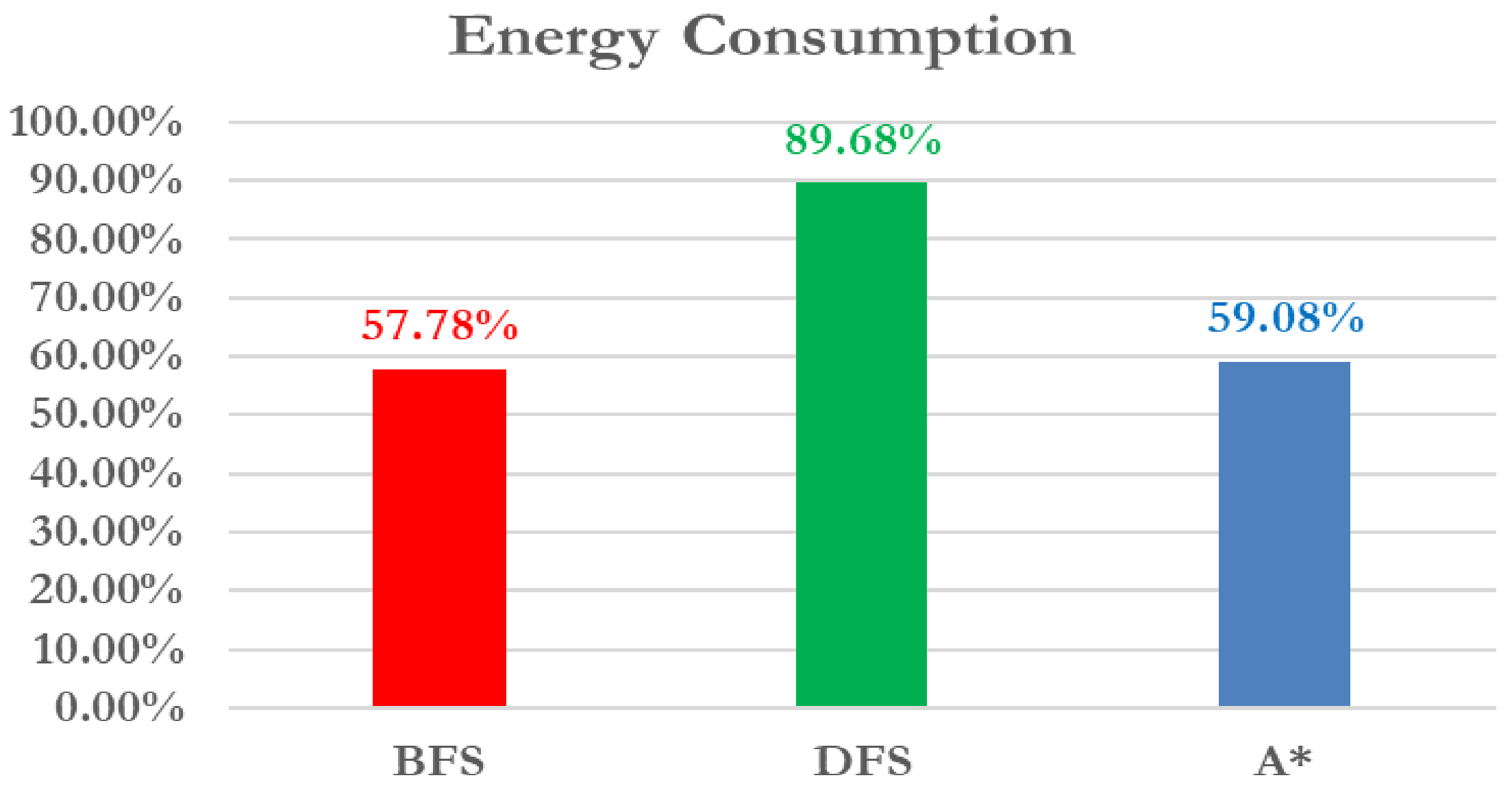
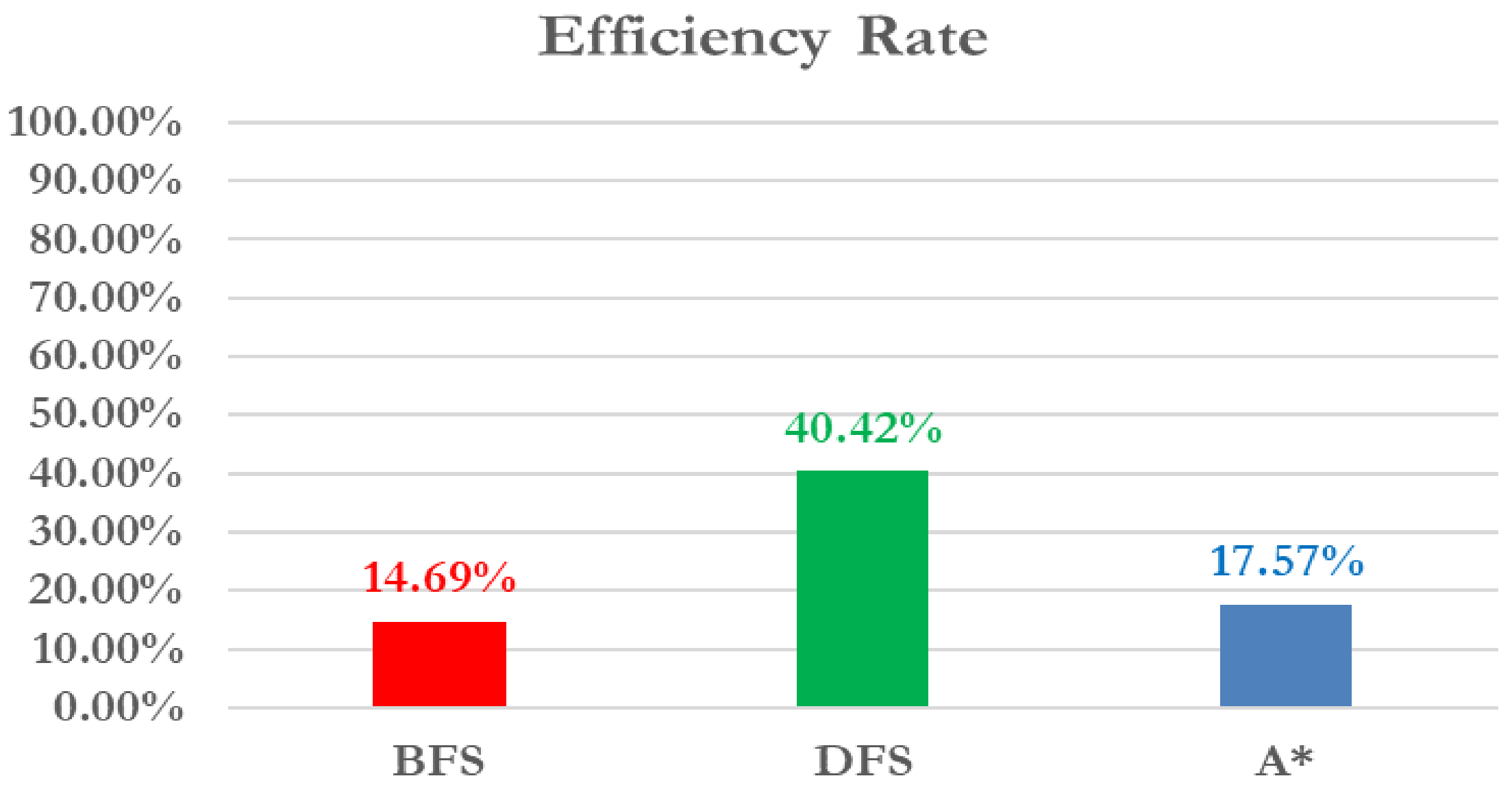
| Algorithm | Complexity | Cost | Quality | Efficiency |
|---|---|---|---|---|
| DFS | ✓ Minimal | ✗ Often sub-optimal | ✓ Most efficient | |
| BFS | ✗ High | ✓ Optimal | ✗ Least efficient | |
| ✗ High | ✓ Optimal (goal) | ✗ Nearly same as BFS |
Disclaimer/Publisher’s Note: The statements, opinions and data contained in all publications are solely those of the individual author(s) and contributor(s) and not of MDPI and/or the editor(s). MDPI and/or the editor(s) disclaim responsibility for any injury to people or property resulting from any ideas, methods, instructions or products referred to in the content. |
© 2025 by the authors. Licensee MDPI, Basel, Switzerland. This article is an open access article distributed under the terms and conditions of the Creative Commons Attribution (CC BY) license (https://creativecommons.org/licenses/by/4.0/).
Share and Cite
Polenakis, I.; Anagnostou, M.N.; Vlachos, I.; Avlonitis, M. A Low-Cost, Energy-Aware Exploration Framework for Autonomous Ground Vehicles in Hazardous Environments. Electronics 2025, 14, 3665. https://doi.org/10.3390/electronics14183665
Polenakis I, Anagnostou MN, Vlachos I, Avlonitis M. A Low-Cost, Energy-Aware Exploration Framework for Autonomous Ground Vehicles in Hazardous Environments. Electronics. 2025; 14(18):3665. https://doi.org/10.3390/electronics14183665
Chicago/Turabian StylePolenakis, Iosif, Marios N. Anagnostou, Ioannis Vlachos, and Markos Avlonitis. 2025. "A Low-Cost, Energy-Aware Exploration Framework for Autonomous Ground Vehicles in Hazardous Environments" Electronics 14, no. 18: 3665. https://doi.org/10.3390/electronics14183665
APA StylePolenakis, I., Anagnostou, M. N., Vlachos, I., & Avlonitis, M. (2025). A Low-Cost, Energy-Aware Exploration Framework for Autonomous Ground Vehicles in Hazardous Environments. Electronics, 14(18), 3665. https://doi.org/10.3390/electronics14183665






